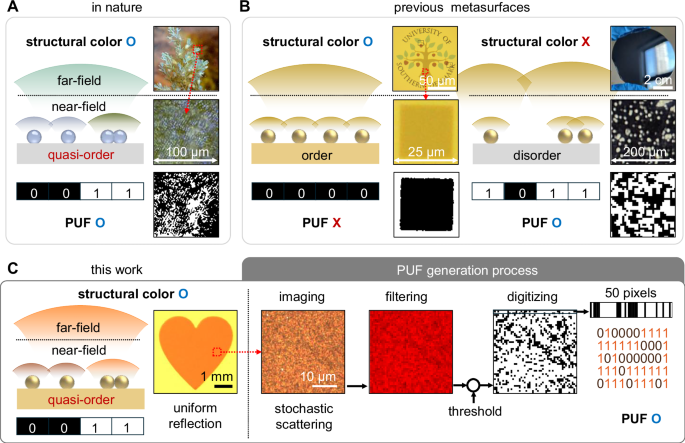Concept of unclonable stochastic scattering with plasmonic metasurfaces
Our design draws inspiration from the naturally occurring quasi-order in micro/nanostructures observed in animal feathers and plant leaves, which create intrinsic stochastic near-field fingerprints while maintaining far-field uniform structural colors (Fig. S1)11,12,13,14,15. To mimic this effect artificially, we begin with a numerical modeling of a plasmonic metasurface comprising gold nanoparticles (Au NPs) positioned just above a metallic mirror, separated by a dielectric gap (Fig. 2A). For instance, a 50 nm single Au NP placed on an Au mirror, referred to as a ‘monomer’, exhibits behavior akin to a dimer pair of two Au NPs, resulting in strong optical near-field coupling within the gap, often termed a ‘hotspot’ (top-left panel of Fig. 2B). This hotspot induces coupled resonant color, enabling the Au NP to function as a fundamental unit for structural coloration, such as a reflection peak at 621 nm when spaced by 20 nm HfO2 layer (Fig. 2C)40. Consequently, when Au NPs cover the entire mirror surface, the uniform far-field reflective color arises from the consistent surface coverage of the Au NPs across the mirror, effectively behaving like a metallic layer and thus acting as Fabry-Perot etalons41.
Fig. 2: Theoretical design of plasmonic metasurface.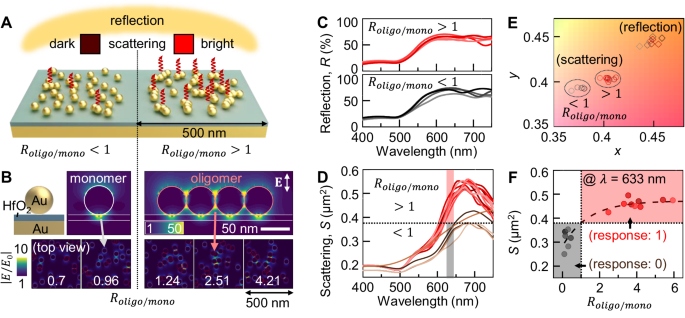
A Schematic of differential scattering colors due to Roligo/mono, the ratio between the forms of oligomers (aggregated Au NPs) and monomers (isolated Au NPs) at the given number density while exhibiting uniform reflective color regardless of the ratio. B Optical near-field enhancements of the monomer (top-left) and oligomer (top-right), and their random distributions as a function of Roligo/mono at the given number density (NP number: 31, area: 500 × 500 nm, bottom panel). C Associated reflection spectra, D scattering spectra, E color gamut plots in CIE 1931 chromaticity, and F scattering intensity at \({\lambda }\) = 633 nm vs. Roligo/mono.
Meanwhile, despite this consistent surface coverage, random local arrangements of Au NPs, termed ‘oligomers’, arise due to varying numbers and orientations of Au NPs, except for a few cases involving nanolithography or nanopatterning42,43. These quasi-ordered oligomers generate additional optical near-field coupling within the gaps between Au NPs (top-right panel of Fig. 2B), resulting in scattering intensities that are 1.5 times stronger than those generated by monomers (Fig. 2D). Interestingly, when defining \({R}_{{oligo}/{mono}}\), the ratio of oligomers to monomers within a given surface area (500 × 500 nm for simulation) while maintaining an overall surface coverage of 24%, and sweeping this ratio from 0.7 to 4.2 (bottom panel of Fig. 2B), the scattering color at the wavelength of 633 nm (for red color) clearly bifurcates into two regimes, i.e., dark and bright scatterings when \({R}_{{oligo}/{mono}} and \( > 1\) respectively, all while maintaining consistent reflective color irrespective of the ratio (Fig. 2E). These distinct scattering behaviors enable digitization of the signals into binary values, ‘0’ and ‘1’ based on whether the ratio is less than or greater than 1 (Fig. 2F). Moreover, this approach generates stochastic scattering patterns with high spatial resolution (e.g., Fig. 3), making it highly suitable for scattering-based physically unclonable function applications.
Fabrication of plasmonic metasurfaces
The key to enabling quasi-order in the plasmonic metasurface involves the self-assembly of colloidal Au NPs into the monolayer, essentially causing the various structural forms of Au NPs (Fig. 3A)44. Our approach thus utilizes an electrostatic assembly method where chemically synthesized colloidal Au NPs (ca. 50 nm) are drop-cast onto an Au film patterned with HfO2 (Fig. 3B, see “Methods” and Fig. S3 for details). Unlike traditional electrostatic assembly, we employ a recently developed technique45, involving the use of protons to dissolve hydroxyl groups on the surface, thereby exposing the intrinsic surface charges, i.e., negative for Au film and positive for HfO2 patterns. This approach enables the rapid and selective assembly of negatively charged Au NPs onto the positively charged HfO2 patterns within seconds, while the Au film remains uncoated due to electrostatic repulsion46, Fig. 3C. Since this assembly follows the adsorption kinetics of Langmuir isotherms, the surface coverage of Au NPs can be effectively controlled by the assembly time47. For example, the surface coverage can be tuned from 8 to 24% by varying the assembly duration from 1 to 60 s (Fig. 3B, see “Methods” for image analysis)48.
Fig. 3: Fabrication of plasmonic metasurfaces.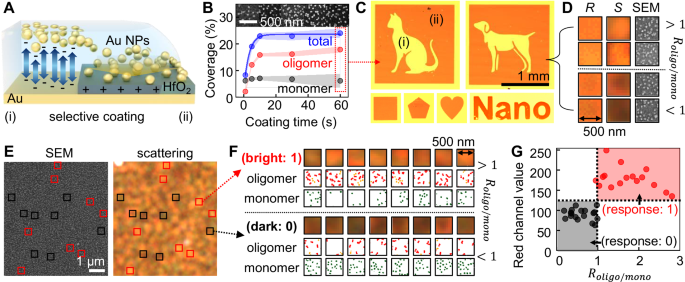
A Selective Au NPs transfer via electrostatic nanoparticle assembly. B Surface coverages of the total Au NPs at the given area of 2 × 2 μm (blue) and their forms of oligomer (red) and monomer (black) vs. coating time (inset: associated SEM images). C Plasmonic metasurfaces with various patterns and D their corresponding reflection, scattering, and SEM images at different Roligo/mono. E SEM and scattering images of the plasmonic metasurface with randomly selected bright (red box) and dark areas (black box, each area: 500 × 500 nm). F Their corresponding scattering colors (top) and numbers of oligomer (middle) and monomer (bottom) analyzed and extracted from the SEM image. G Associated red channel value vs. Roligo/mono.
We deliberately select the surface coverage of 24% for the Au NPs, as this not only achieves nearly half of the theoretical maximum surface coverage for quasi-ordered spheres (54%)49, an optimal condition for binary operation, but also yields a vivid and uniform reflective color across the entire metasurface (Fig. 3C). Crucially, at this surface coverage, over 70% of Au NPs form oligomers, leading to bright scattering, which we assign as the response ‘1’ in the binary operation (Fig. 3D). To experimentally validate this, we randomly select 18 areas from a single plasmonic metasurface and compare the structural forms of Au NPs observed in SEM images with their corresponding scattering colors and intensities (Fig. 3E). Each bit in the scattering PUF key from the plasmonic metasurface corresponds to a 670 × 670 nm surface area, containing an average of 54 Au NPs and matching 10 × 10 pixels in the scattering image obtained through a ×100 objective lens. As expected, the 8 bright local areas mostly contain high proportions of oligomeric Au NPs when \({R}_{{oligo}/{mono}} > 1\) (Fig. 3F, total 18 in Fig. S4). In contrast, the dark local areas are predominantly occupied by the monomeric Au NPs when Roligo/mono Roligo/mono, making it more distinct (Fig. 3G). This allows us to digitize the image into binary responses (0 and 1) by applying a threshold value of 128 to the red channel, whereas the green and blue channels do not produce functional results (Fig. S5). These observed trends align closely with the numerical simulations presented in Fig. 2F, establishing a robust foundation for generating a binary PUF response from the original scattering image (Fig. 1C for the PUF key generation process). For the overall analysis, we utilize a 50 × 50-bit array of the PUF key by binning 500 × 500 pixels from the scattering image, which corresponds to a 33.5 × 33.5 μm area of the quasi-ordered plasmonic metasurface, ensuring efficient image processing.
Performance of scattering PUF keys
To systematically evaluate the performance of scattering PUF keys, we fabricate 22,500 PUF keys using Au NPs with a surface coverage of 25% on an array of square HfO2 patterns (100 × 100 µm surface area, 25 nm thickness, Fig. 4A). The electrostatic coating process enables rapid, selective ‘pick-and-place’ assembly of Au NPs onto the HfO2 regions, leaving the surrounding Au surfaces clean. To statistically evaluate the performance of an infinitely large set of PUF keys based on the small sample technique50, we randomly select 500 quasi-ordered plasmonic metasurfaces, all of which exhibit nearly identical reflective hues to the human eye, with negligible perceptible variation (left panel of Fig. 4A). Meanwhile, each metasurface contains unique, unclonable stochastic scattering patterns (right panel of Fig. 4A), enabling the generation of individual PUF keys encoded as binary data (0 and 1) in 50 × 50-bit array (Fig. 4C). The recording and processing time is on the order of seconds, with the potential for further optimization via computational algorithms51. Crucially, the bit uniformity between the 0 and 1 responses across all 500 PUF keys closely approaches the ideal value of 0.5 (average: 0.501, standard deviation: 0.028, Fig. 4C). This uniformity is preserved across variations in light intensity, integration time, incident angle, and camera digital gain (Fig. S6), ensuring robustness in real-world scenarios. Although the scattering behavior in plasmonic metasurfaces is influenced by the mirror–nanoparticle coupling, which exhibits a resonance within the 45–90° range of incident light angles52, most ×100 objective lenses essential for high-resolution scattering imaging have a numerical aperture exceeding 0.7, inherently satisfying this angular requirement and eliminating any angular dependence. This consistency provides a robust foundation for reliable PUF performances (see Figs. 4B, S7, and Supplementary Note 1 for details).
Fig. 4: Performance of scattering PUF keys.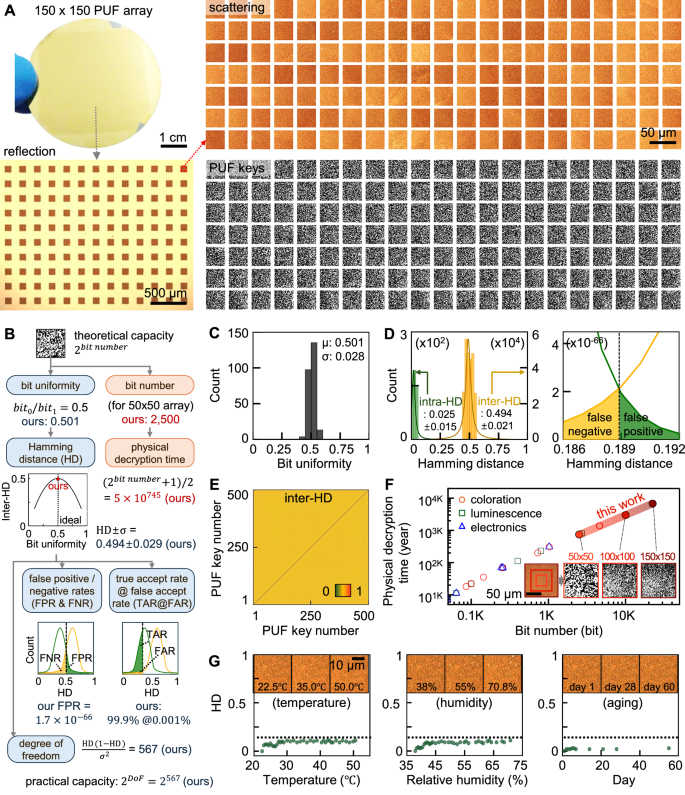
A Wafer-scale plasmonic metasurfaces (top), reflection (bottom). scattering images of fabricated plasmonic metasurfaces (each area: 100 × 100 μm), and their generated PUF keys (right). B A diagram illustrating the correlations between PUF performance metrics and C bit uniformity, D inter- and intra-Hamming distances (left), Gaussian fits (right), and E 2D pair inter-Hamming distances. F Average physical decryption times of the scattering PUF keys with different bit arrays (50 × 50, 100 × 100, and 150 × 150), compared with 36 literatures22,24,29,30,31,35,36,37,38,64,71,72,73,74,75,76,77,78,79,80,81,82,83,84,85,86,87,88,89,90,91,92,93,94,95,96. G Thermal, humid, and aging stabilities of the scattering PUF key.
We then firstly consider the Hamming distance, which quantifies the uniqueness of PUF keys and ideally approaches 0 when the same PUF key is measured multiple times (left panel of Fig. 4D)53. This intra-Hamming distance reflects the stability of both the detecting device and method, and in our case, it is found to be 0.025 (standard deviation: 0.015), indicating high detection fidelity. In contrast, when calculating the inter-Hamming distances among all possible 500 PUF key pairs, we obtain an average of 0.494 (standard deviation: 0.021, Fig. 4E), confirming the high uniqueness of the scattering PUF keys. To establish a robust authentication threshold, we fit the intra- and inter-Hamming distance distributions to Gaussian profiles, identifying a crossover threshold of 0.189 (right panel of Fig. 4D). This threshold results in a false negative rate (\(3.8\times {10}^{-71}\)) and a false positive rate (\(1.7\times {10}^{-66}\)), comparable to or lower than those previously reported values (Table S2). The crossover profiles further define the true acceptance rate at false acceptance rate (TAR@FAR), a key metric for evaluating authentication security32,54. For example, a system achieving TAR 90% @ FAR = 0.001% successfully blocks 99.999% of unauthorized access while allowing 90% of legitimate users to pass. Our scattering PUF system exceeds this standard, achieving TAR 99.9% @ FAR = 0.001% at a Hamming distance threshold of 0.40121, surpassing the TAR > 95% @ FAR = 0.01% benchmark set for biometric authentication systems such as fingerprint and iris recognition55. Furthermore, binary bit streams extracted from the scattering PUF keys successfully pass all seven statistical tests, as officially approved by the National Institute of Standards and Technology (NIST SP 800-22, Table S3)56, ensuring the randomness and reliability of the generated security keys. Then, the practical key capacity of a 50 × 50-bit PUF key is statistically estimated from the degree of freedom in inter-Hamming distance distributions. While the theoretical maximum for a 50 × 50-bit arrayed PUF key is 22500, the practical key capacity of our system is estimated at \({2}^{567}\), sufficient to assign a unique PUF key to every item in the global population (~8 billion)57. This scalability is attributed to the high degree of freedom in this PUF key system.
On the other hand, the physical decryption time required for physical decryption under random guessing attacks is primarily dependent on the bit number (Fig. S8)30. Since fabrication details of PUF keys may be publicly available through research publications or patents, potential attackers could attempt to replicate PUF keys through iterative replacement until successful authentication is achieved. To estimate the physical decryption time under such conditions, we assume that attackers iteratively swap counterfeit PUFs until an identical key is found. Under this scenario, the estimated average physical decryption time is 5 × 10745 years for a scattering PUF key with a 50 × 50-bit arrays, increasing up to 106773 years for a 150 × 150-bit arrays, longer than previous optical and electrical PUF keys (Fig. 4F). This renders the false authorization almost impossible within a human lifespan.
Beyond these security metrics, environmental stability is crucial for real-world implementation, as randomly structured nanomaterials often undergo restructuring, corrosion, or degradation under external stimuli (e.g., heat, moisture, mechanical stress, light source condition)41,58. Such changes could alter the scattering properties of the PUF, compromising authentication integrity. To assess durability, we analyze the scattering PUF key under varying temperatures from 22.5 to 50.5 °C at 38% relative humidity (left panel of Figs. 4G, S9A), and under varying relative humidity from 38 to 70.8% at a constant temperature of 24 °C (middle panel of Figs. 4G, S9B). Note that the scattering images remain unchanged across all conditions, with the Hamming distance consistently below the 0.189 threshold, confirming the PUF key’s resilience. Furthermore, over a two-month observation period, only negligible changes are noted with a maximum Hamming distance of 0.03, still below the threshold, stemming from the use of chemically inert inorganic materials in the scattering PUF key (right panel of Fig. 4G, S10). These results confirm that our PUF keys maintain signal integrity despite external environmental changes, ensuring their feasibility for practical security applications in textiles, pharmaceuticals, and high-value consumer goods30,59.
Colorful plasmonic metasurfaces with scattering PUF keys
The beauty of Fabry-Perot etalon resonators lies in their ability to produce vivid reflective colors, which can be finely tuned across the visible spectrum by simply adjusting the thickness of the dielectric gap41. This straightforward yet powerful mechanism is also crucial in engineering the far-field reflective colors of the quasi-ordered plasmonic metasurface (Fig. 5A). As the gap thickness varies from 25 to 95 nm, the wavelength of light trapped within the gap between the Au NPs and the mirror redshifts (left panel of Fig. 5B), allowing the far-field reflective color to cover the entire visible spectrum (see “Methods” and Fig. S11 for simulation details), Fig. 5C. This trend shows a strong qualitative agreement between simulation and experiment. The average reflectance of the fabricated quasi-ordered plasmonic metasurface exceeds 55%, making it clearly observable to the naked eye (top panel of Fig. 5D).
Fig. 5: Plasmonic metasurfaces with various dielectric gap.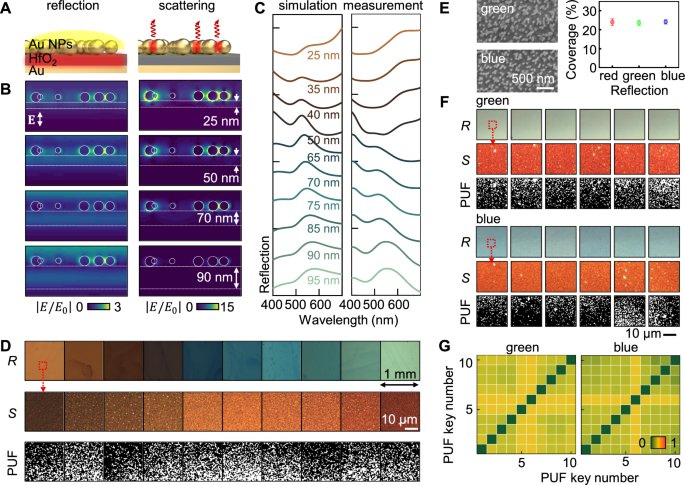
A Plasmonic metasurface with gap-driven uniform reflection (left) and plasmonic oligomer-driven stochastic scattering (right). B Optical near-field enhancements of the plasmonic metasurfaces with different HfO2 dielectric gaps (left: enhancements within gaps for reflection, right: enhancements between nanoparticles for scattering). C Associated reflection spectra (left: simulation, right: measurement), D reflection (top) and scattering images (middle), and their generated PUF keys (bottom). E Surface coverages of the total Au NPs at the given area of 2 × 2 μm for quasi-ordered plasmonic metasurfaces exhibiting red, green, and blue reflective colors. F Associated reflective colors from various devices and their scattering and generated PUF keys with G 2D pair inter-Hamming distances (left: green, right: blue).
Conversely, despite variations in the gap thickness, the scattering from these color-varying plasmonic metasurfaces retains stochastic features with a reddish hue and an intensity of ~5%, along with high spatial resolution (middle panel of Fig. 5D). This is attributed to the optical near-field coupling of oligomeric Au NPs on the mirror (right panel of Figs. 5B, S12) and remains independent of the gap-driven reflective colors, enabling all plasmonic colors to generate unique scattering PUF keys (bottom panel of Fig. 5D), unattainable with existing plasmonic metasurfaces as demonstrated in Fig. 1B27. We further verify the uniqueness of PUF keys for green and blue, fabricated at gap thicknesses of 90 nm and 65 nm, respectively, while maintaining a constant surface coverage of Au NPs (~24%) (Fig. 5E). This consistent surface coverage ensures the uniqueness of PUF keys while displaying uniform reflective colors (Fig. 5F), with mean inter- and intra-Hamming distances of 0.48 and 0.015, confirming weak correlation between different PUF keys (Figs. 5G, S13). Thus, regardless of the reflective color seen by the human eye, these quasi-ordered plasmonic metasurfaces inherently produce unclonable stochastic scattering patterns, making them ideal for colorful camouflage with hidden authentication codes.
Application of plasmonic camouflages with scattering PUF keys
The quasi-ordered plasmonic metasurface uniquely integrates stochastic scattering PUF keys with tunable far-field reflective colors, enabling camouflage or selective highlighting of authentication information. This dual functionality makes it an ideal platform for covert security applications (Fig. 6). Utilizing the color palette obtained by varying the thickness of the dielectric gap, we fabricate a university logo with primary RGB colors, each corresponding to a specific thickness of the HfO2 gap thickness (red: 35 nm, green: 90 nm, blue: 65 nm, Fig. 6A). A three-step shadow mask patterning process permits to deposit various sections of HfO2 patterns with varying thicknesses on a 2-inch Au mirror (Fig. S3B), followed by uniform electrostatic self-assembly of Au NPs at 25% surface coverage (see Supplementary Video 1). Despite differences in dielectric thickness, each patterned region maintains high reflectance (>50%), making the colors clearly visible (left panel of Fig. 6B). More importantly, while these regions exhibit uniform far-field reflection, they simultaneously generate distinct stochastic near-field scattering, allowing each area to encode a unique PUF key (middle and right panels of Fig. 6B). To enhance mechanical durability for real-world applications, we encapsulate the metasurface with a transparent, scattering-free polyimide layer (50 μm thickness, Fig. 6C). This protective layer effectively protects against mechanical damage while maintaining authentication accuracy. Even after repeated abrasion tests (Supplementary Video 2), the metasurface retains its optical properties, with a Hamming distance of 0.02, confirming minimal alteration.
Fig. 6: Plasmonic camouflages with scattering PUF keys.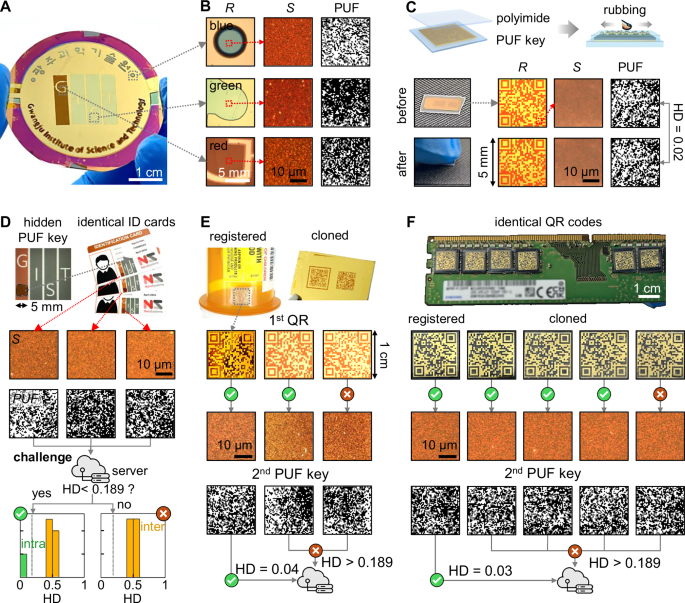
A Plasmonic RGB colorations with different HfO2 thicknesses (red: 35 nm, green: 90 nm, blue: 65 nm), and B their RGB uniform reflection images (left), stochastic scattering images (middle), and generated PUF keys (right). C Scheme of the plasmonic metasurface fabricated on a flexible device and the attachment of a protective film (left), along with the verification of PUF robustness against physical stress (right). D Three different ID cards with hidden scattering PUF keys (left) and their use for authentication (right). E A lithographically patterned QR code-shaped metasurface on a flexible substrate and its cloned counterfeit QR code (top). The authentication process of a dual-layer authentication system using the QR code and hidden PUF key (bottom). F The QR codes on black semiconductor chips (top) and the authentication process using the camouflaged PUF keys within the QR codes (bottom).
Then, for secure identity verification, the quasi-ordered plasmonic metasurface is integrated into a red-brown section of the university logo on an authentic identification (ID) card, completely concealing the scattering PUF key by matching its reflective color (with 20 nm HfO2 gap, CIE code: 61.1, 56.9) to the surrounding color (CIE code: 70.5, 61.4), Fig. 6D. This integration ensures that the PUF key remains invisible to the naked eye, preventing tampering or counterfeiting. To evaluate authentication performance, we pre-register the PUF key in a secure data server and fabricate two cloned ID cards from the same batch of metasurfaces. The authentication process involves (Fig. S14), (1) capturing the scattering pattern using a dark-field optical microscope, (2) extracting the unique PUF key using a custom Python algorithm (middle panel of Fig. 6D), and (3) comparing the extracted key with the database, using Hamming distance thresholding at 0.189 (right panel of Fig. 6D). The authentic ID card produces a Hamming distance below 0.189, confirming its legitimacy, while both cloned ID cards exceed this threshold and fail authentication. This verification process takes only 2.2 s, with potential for further acceleration through optimization of the sorting algorithm60. Thanks to the low false positive/negative rates of quasi-ordered plasmonic metasurfaces, cloning is nearly impossible, significantly enhancing security for identity verification systems.
Beyond concealment, this selective visual integration also enables targeted exposure, offering a promising anti-counterfeiting solution for various products. Building on this concept, we extend our approach to enhance QR code security by embedding hidden PUF keys within matching color regions (Fig. 6E). Quick-response (QR) codes are widely used for product tracking, payments, and authentication, yet remain vulnerable to unauthorized duplication61. To mitigate this risk, we fabricate quasi-ordered plasmonic metasurfaces on a flexible polyimide film, integrating them directly into QR code regions patterned through photolithography. Since QR codes must remain clearly visible regardless of background color while simultaneously concealing embedded PUF keys, selective visualization of the reflective color against the background is crucial. To demonstrate this, we apply orange- and light green-reflective metasurfaces to two different surfaces: a transparent plastic case and the black semiconductor chips of a random access memory (RAM) module (top panels of Fig. 6E, F). In particular, on the black chip, the green-reflective metasurface contrasts sharply against the dark background, making the PUF key visually distinguishable for authentication. While the QR code itself enables rapid identification (middle panels of Fig. 6E, F), counterfeit risks persist if multiple items share the same QR code. To prevent this, the embedded hidden PUF key is cross-verified with the server’s record, ensuring authenticity (bottom panels of Fig. 6E, F). This dual-layer security approach guarantees that even if a QR code is cloned, the underlying PUF key remains unclonable, providing an additional safeguard against counterfeit goods.
The flexible nature of the polyimide-based metasurfaces potentially allows for attachment to a wide range of products, making them ideal for securing pharmaceuticals (e.g., drug packaging with invisible authentication layers to prevent medication fraud)35, luxury goods (e.g., handbags, watches, and jewelry with hidden PUFs for counterfeit protection), high-value electronics, and cosmetics with tamper-proof security labels62. Considering economic feasibility, while the use of gold increases unit costs (Table S1), it remains adaptable for mass production, particularly in luxury and high-value markets. Although high-magnification microscopes are used here, portable dark-field microscopes integrated with smartphone cameras are emerging as low-cost, user-friendly authentication tools63. These advancements suggest that real-time, consumer-accessible authentication systems could soon be implemented without requiring laboratory-grade microscopes. Overall, the scalability, flexibility, and industrial feasibility of these metasurfaces position them as a next-generation security solution for covert authentication and anti-counterfeiting applications.
We successfully demonstrate quasi-ordered plasmonic metasurfaces, exhibiting tunable structural coloration without compromising either far-field uniformity or near-field stochasticity—an ability rarely observed in artificial systems. Through the electrostatic self-assembly of gold nanoparticles on a patterned metallic mirror, we achieve precise control over reflective colors across the visible spectrum by engineering the dielectric gap thickness, while simultaneously generating stochastic scattering patterns that function as robust physically unclonable functions. This approach unlocks a new paradigm in security authentication, where optical visualization and covert identification coexist. These PUF keys, rigorously validated through NIST SP 800-22 statistical testing, exhibit exceptional uniformity, uniqueness, and stability across all colors, ensuring unprecedented reliability against duplication. Notably, the PUF performance can be further enhanced through increased imaging resolution or expanded fabrication areas, both enabling extended bit number (thus increasing physical decryption time). Moreover, we demonstrate real-world applications by integrating these metasurfaces into concealed security elements, such as camouflaged PUF keys in ID cards and embedded authentication in QR codes, showcasing their viability for next-generation anti-counterfeiting technologies30,64. The scalable manufacturing process and intrinsic authentication capability further offer promising integration with plasmonic sensing65, imaging66, and display technologies67, paving the way for cost-effective, industrial-scale adoption while maintaining high security and uniqueness.
